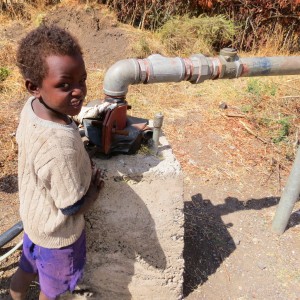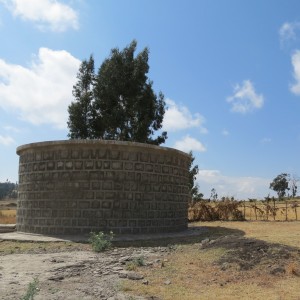Thank you for your support of the Gonbisa Kussaye project, which will serve 2,000 people. The community is on schedule for completing their piped water system which will provide clean, convenient water supplies — ending the long, arduous walk for water for women and girls. During our visit, the community was excavating some of the 8 miles of pipeline trench needed to complete the project.
 Coordinating construction of the project
Coordinating construction of the project
The community construction coordinator organizes the volunteer labor. Each family is responsible for providing a certain amount of labor each week to build the new water system. This reduces construction costs, but more importantly, allows community members to demonstrate their dedication to the project. The book he’s holding above documents each family’s work hours to be sure everyone contributes a fair share.
 Developing a clean water source and ensuring it stays protected
Developing a clean water source and ensuring it stays protected
To the right is the well-head of the approximately 450-foot deep mechanically-drilled well, which accesses a clean and abundant groundwater source. A pump test was performed to ensure the aquifer is able to meet the needs of Gonbisa Kussaye both now and as the community grows.
Our projects typically focus on identifying a clean and sustainable water supply, and keeping it clean. This means that our projects may cost more up-front to perform activities such as drilling a well. However, protecting an already-pristine water source is much less expensive over time than ongoing treatment to remove contaminants, and low maintenance costs are important for sustainability in low-income communities.
Supplying power to the well pump
A diesel generator is needed to provide the electricity to power a submersible pump that efficiently delivers the water from the well to a storage tank. Many of the communities where we work in Ethiopia do not yet have access to the electric power grid. Once the electric grid reaches Gonbisa Kussaye, they will make the change to this less-expensive source of power, and we will be able to use the generator in another project.
 Building storage in the water system reduces ongoing operation costs
Building storage in the water system reduces ongoing operation costs
The water will be pumped to a 20,000 gallon storage tank (right). The storage tank is completed. From there the water will flow to 9 public taps spread about the community. Building storage in the system is another up-front cost that reduces ongoing operations costs, allowing the well pump to operate a few hours every few days, in order to fill this storage reservoir, rather than constantly.
A future public water tap
Construction of other public taps will allow up to six people to fill containers simultaneously, making water collection convenient because there will be no waiting in line. Five of the nine public taps are completed but not plumbed. The main activity remaining in the project is construction of the pipeline.
Ensuring the Gonbisa Kussaye project has money available for operations and maintenance
 Once complete, the water points will look like the one above. Community members will go to the nearest water point (no more than 500 meters away). They will pay the equivalent of 2 cents for each jerry can of water they collect. Tap attendants will open the water points twice a day. There is a meter at each water point and the tap attendant pays the water committee for the volume of water dispensed from that water point each month. For all that work and responsibility, tap attendants receive a small monthly salary.
Once complete, the water points will look like the one above. Community members will go to the nearest water point (no more than 500 meters away). They will pay the equivalent of 2 cents for each jerry can of water they collect. Tap attendants will open the water points twice a day. There is a meter at each water point and the tap attendant pays the water committee for the volume of water dispensed from that water point each month. For all that work and responsibility, tap attendants receive a small monthly salary.
With all the structural elements in place, the community has a lot of incentive to complete the pipeline trench. Eight miles is a lot of trench to dig, but time and again these communities complete that work with simple hand tools, demonstrating the importance of the water project to their lives. A recent University of Washington study on our project in Bishikiltu measured the labor savings at 80 minutes per household per day. No other single intervention can have that magnitude of impact on the lives of the world’s poorest.


